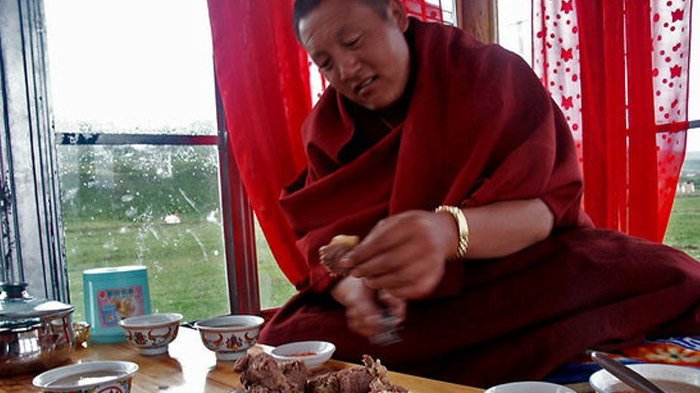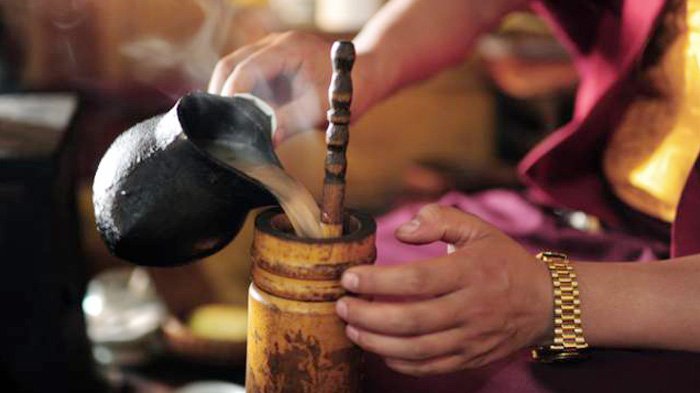Monks are some of the most revered members of society here in Tibet. They are viewed as the ultimate source of spiritual guidance, and—with their radiant beauty, and abundant, youthful energy—the pinnacle of optimal health. For this latter reason, it is often found that even those who do not subscribe to any particular religious faith are longing to emulate these holy men. And since we are what we eat, we’re digging into the details of a traditional Tibetan monks’ diet in an effort to become more like these men we hold in such high esteem.
 |
| Lacking fresh produce on the plateau, it's acceptable for Tibetan monks to dine on "clean meat". |
First thing’s first, what exactly do they eat?
Tibetan monks are known to eat a diet high in vegetables and fruits, limiting their intake of proteins, fats and starches. Their approach to the consumption of foods such as eggs, butter and cheese? Eat the bare minimum, only enough to meet the body’s needs. For this reason, healthy individuals who have their nutrient requirements met go without these richer foods for periods of time, only returning to consuming them when need be.The question of whether or not eating meat is acceptable is a perplexing one because there is no clear cut answer. Many Buddhist monks abide by vegetarianism, but then there are some, particularly those of the Yoga Tantric branch, who believe it is acceptable to dine on “clean meat,” especially since some regions of Tibet have sparse availability of fresh produce. For meat to qualify as clean, the individual who is to eat the flesh cannot have seen the animal from which it comes been brought to its death. In this same vein, the eater must be certain that the animal was not sacrificed directly for him- or herself.
Also of note, those who opt to eat meat will only consume cloven-hoofed animals (read: deer, antelopes, goats, sheep, cattle and gazelles), and will only do so when they can purchase them directly from the market.
Typical staples of a Tibetan monk’s diet include salads, beans, lentils, noodle soups, and stir-fried or steamed vegetable dishes. Simple and always seasonal, as they believe that which is presently growing on this earth is the exact food we are meant to be eating at this time of year for optimal nourishment.
The approach to consumption
To really understand a Tibetan monk’s diet, it may be more fruitful to look at how they eat rather than the minute details of the food itself.Food combining
Keeping starches, fruits and vegetables separate from meat dishes, including fish and fowl, is key. It’s believed that the starchier foods (like bread, rice, and pasta) do not sit well in the stomach when consumed with foods higher in protein because of the difference in the ways these foods get digested.
To break down starchy foods, the body needs an alkaline environment, whereas to break down something like a steak, it requires a very acidic landscape. So, when you introduce two foods that promote opposite conditions in the stomach that cancel each other out, you end up with a neutral, ineffective environment. As a result, nothing gets digested well.
This is also why fruit is to be kept separate from other foods, because of the quicker rate at which it is broken down. The rule of thumb? Always eat fruit thirty to sixty minutes prior to other foods, to prevent internal distress. When your digestion is off, this tends to manifest immediately as pain and bloating of the stomach, and, importantly, the Tibetan monks believe that in the long term this can lead to a shorter lifespan.
Mono-Diet
In line with their beliefs surrounding food combining, the monks often spend chunks of time eating just one type of food as a type of cleansing practice. This utterly simple approach to feeding oneself is found to be easier on the stomach because it ensures there is no clash in terms of digestion. Examples of foods that have been eaten by monks in this style are bread, watermelon, potatoes, squash, carrots, and even meats.
Chew slowly
When you take the time to ensure you thoroughly masticate, you’re giving your body a heads up that food is on its way down to the stomach. This signal starts the process of digestion as those necessary juices that help break down your food become active and promote optimal nutrient absorption. Remember - the more work your teeth do, the less your stomach has to. So for less bloat, chew, chew chew.
Not too late
Because the process of digestion requires energy from the body, the monks are careful not to feed themselves late in the day. Optimal sleep is a priority for them, and this requires a slowing down of the bodily systems, a state of relaxation. This state runs contrary to the one signalled by the body when it receives food. So, ideally, the last meal is consumed prior to sundown, a few hours before laying down to rest.
Eats as a group and in silence
Eating is often done at the same time every day, and always following the practice of meditation. So, when monks come together at mealtime, they are still in this state of prayer and deep relaxation. Although they are eating communally, they take their meals in utter silence, which keeps them focused on their food and their satiation, making sure not to overeat.
No snacking or sneaking
Since it is tradition to come together and treat the feeding of oneself as a sacred act, sneaking food between meals when one is alone is simply not apart of the food philosophy. It is not mindful and therefore not done.
Why do they abide by this style of eating?
Aside from optimal digestion promoted in their food combining and slow, conscious eating style, there are a number of other benefits that come from eating like a monk in Tibet.Namely, vibrancy and vitality. With pure, whole foods making up the entirety of the diet, that leaves no room for processed junk, which leaves us feeling sluggish, lacklustre and prone to sickness. In place, we’re consuming colourful, live foods that are nutrient-dense and give us back that long sought after youthful vigour.
In addition, we get spiritual benefits from eating in this way. Learning to treat mealtime as a communal, sacred experience makes us thankful for what we are consuming, and promotes sociability. Plus, in reverting to eating such unprocessed dishes as those enjoyed by the monks, we can appreciate the beauty of simple, meek food, coming to understand that we do not need fancy foods to satisfy us. With that mindset shift, we become free from food trends and can find solace in knowing we can survive on poor man’s meals like lentils and beans.
A traditional meal and drink to try
String Beans with PotatoesThis hot dish is comprised of predominantly beans and potatoes, which are cut into small strips so that they match in shape and size with the beans. To enhance taste, the vegetables are fried in oil. The mélange gets its delectable flavour from the onions, herbs and spices the veggies are sautéd in: garlic, paprika, ginger root, and chilli peppers. At the end, boiled tomatoes and chunks of tofu are added, along with a splattering of soy sauce, a dash of red pepper and salt, and a sprinkling of finely chopped green onions.
 |
| String beans are fried with potatoes |
Yak Butter Tea
Butter is regarded as one of those special ingredients in Tibet, the only that combines nicely with both starches and proteins, and capable of producing the miraculous results it does when added to black tea. Mountain climbers have come to rely on yak butter tea—made traditionally with black Pemagul tea—when they embark on expeditions. They claim it wards off plateau sicknesses and brings them immeasurable energy. You can make your own using any black tea you may have, and adding in butter, milk and a dash of salt.
 |
| A Tibetan monk is making yak butter tea |
We can’t wait to try incorporating more Tibetan meals into our daily routine and begin experimenting with the monks’ mindful approach to ingesting food. Remember: slowly, thoroughly and in humble quantities. Curious about other areas of a Tibetan monk’s lifestyle we can benefit from? Try meditation, sleeping eight hours, taking baths, and engaging in regular exercise.


No comments
Post a Comment